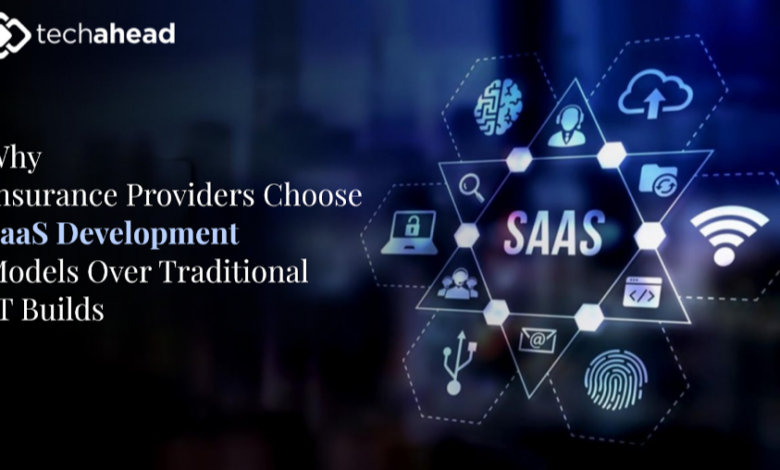Why Insurance Providers Choose SaaS Development Models Over Traditional IT Builds

The insurance industry is becoming digital at full pace, as customer demands shift, regulatory issues arise and they seek to perform their work more effectively.
Conventional IT models are not always able to keep pace with this, and insurance providers are looking for more scalable and flexible solutions. Majority of the enterprises are adopting Software-as-a-Service (SaaS) models to upgrade their platforms which provide smooth online experiences to their users.
This may look like a small integration but by embracing SaaS alongside specialized insurance app development services, providers are finding new ways to innovate without the limitations of traditional infrastructure. Let’s have a look at some of these.
Quick and Rapid Time-to-Market
Responding to the changing market demands, customer needs and compliance requirements is one of the biggest challenges faced by insurance companies. The traditional IT systems are characterized by the long development cycles, huge investments on hardware and integrations that slows down innovation.
On the contrary, SaaS designs are agile with cloud-based ready-to-use frameworks and scalable tools. Standardized modules will help insurers to implement digital platforms faster and customize functionality to business goals. This speed of deployment does not only improve the time-to-market, but it also allows providers to experiment, test, and iterate with little risk.
Economy and Foreseeable Expenditure
Traditional IT infrastructure can be expensive to build and maintain due to initial costs of servers, software licenses and maintenance expenses. These high costs are a barrier to innovation to many insurance providers and can be a limitation to growth.
SaaS does not require extensive initial investment because it converts expenditure into subscriptions. Under this pay-as-you-go model, the costs will be predictable and it is easier to budget and predict the costs to the insurers.
Also, the SaaS provider handles patches, security upgrades, and updates in real-time, which eliminates pressure on internal IT units.
Scalability to Meet Changing Business Needs
The insurance business is concerned with the changing workload, seasonal spikes in claims processing, and unpredictable influx of customer requests. Conventional IT constructions tend to be stiff, and resources can hardly be scaled vertically or horizontally.
With the adoption of SaaS based models, insurance providers are able to manage high demand as scalability becomes easier.. They can put in new functions, integrate with third-party systems, or expand to new markets. But SaaS platforms can make it quick and easy to implement without the delays of hardware upgrades or the time-consuming development.
The scaling may assist the providers to adequately address both temporary peaks and long-term growth strategies to boost customer satisfaction and resilience in operations.
Increased Security and Compliance Support
In the case of insurance companies, protection of confidential customer information and compliance with stringent regulatory measures are not a bargain. The compliance requirements are typically too dynamic to be supported by the conventional IT environments and subject the providers to risks.
SaaS providers normally make huge investments in effective security measures, encryption systems, and compliance standards. These providers are aware of the evolving regulations, and they have built-in compliance tools that ease the load on insurers.
The two advantages of SaaS in companies operating within complex regulatory settings are improved data security and easier administration of compliance. This assures confidence among the customers and compliance with regulations.
Read also: Evolution Of stn lcd Technology
Improved Customer Service and Invention
Insurance customers have become a modern customer who demands quick and digital-centric interactions with insurance companies, whether they need a quote or a claim. The outdated IT structures are not normally in a position to meet these expectations, as they are too slow to respond and have old user interfaces.
Customer-centric SaaS solutions tend to have a user-friendly dashboard interface, self-service portals, and Chatbots powered by AI, which allows them to provide their customers with a real-time customer experience.
On top of this, SaaS solutions can also be easily combined with other emerging advanced technologies such as AI, machine learning, and predictive analytics which enhances satisfaction and increases customer loyalty.
Last Say
The move to SaaS development models is part of an overarching industry trend of agility, scalability, and innovation. A huge number of insurance companies are moving towards Saas to reduce costs, time-to-market, boost security, and deliver superior customer experiences.
As the digital transformation is still steadily disaggregating the industry, providers that adopt SaaS will be better placed to survive in a place where change is the new order of the day.
To fully capitalize on the benefits of this model, a collaboration with an experienced SaaS app development company is required to assist insurers in creating trusted and future-proof solutions that address the expectations of the customers and regulatory demands.



